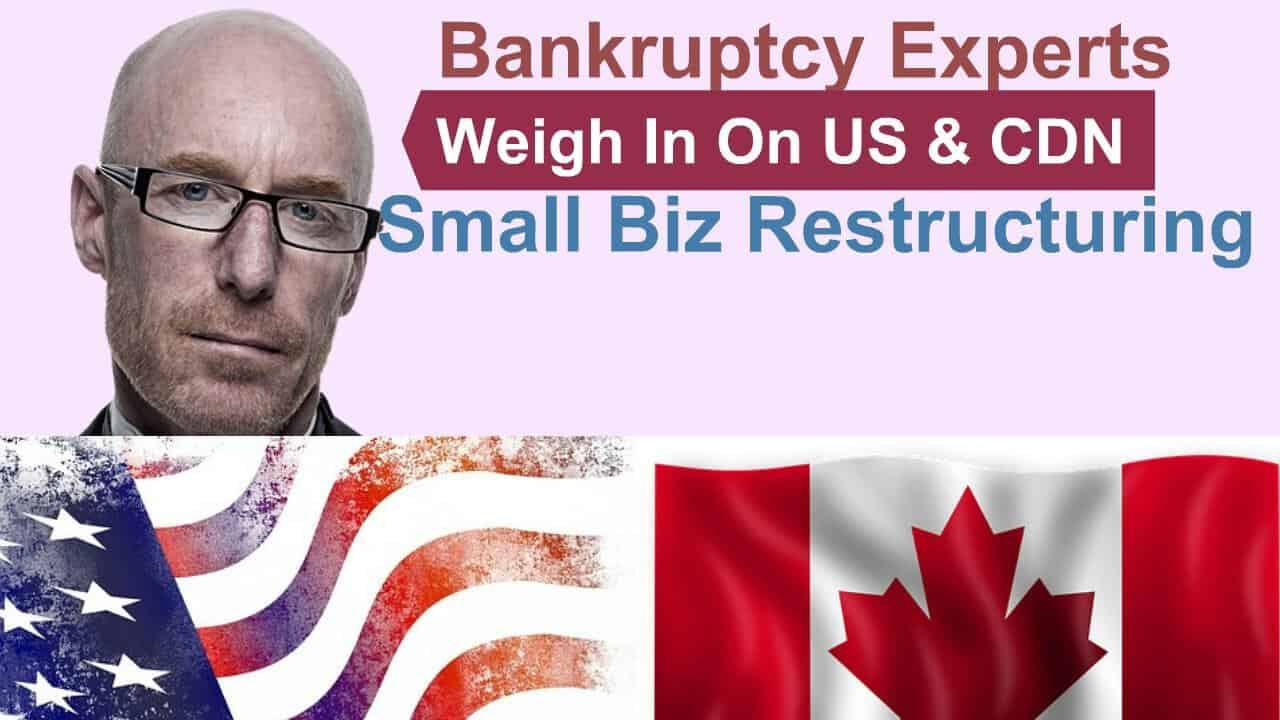The Ira Smith Team is absolutely operational and both Ira, as well as Brandon Smith, are right here for a telephone appointment, conference calls and also virtual meetings.
Stay healthy and safe everybody.
<h2
Consumer proposal in Ontario: Introduction
The Superintendent of Bankruptcy (OSB) went to Court in Toronto on April 24, 2020, to see if consumer proposals in Ontario tested positive for the coronavirus. The Honourable Chief Justice Morawetz issued his decision on Monday, April 27. He put it to the test and it came out testing positive. The OSB is making similar applications in all the different provinces to obtain the same relief. In this Brandon’s Blog, I explain everything.
Consumer proposals in Ontario: The issue
In Ontario, an emergency was proclaimed on March 17, 2020, and the Courts were closed, except for proven emergency situations. This emergency status was extended from April 14 until May 12, 2020, subject to further review. The clock on any provincial limitation period for any proceeding in Ontario was stopped, retroactive to March 16, 2020 (Suspension Period). Ontario is not unique in this. All other provinces have taken similar action.
The closure of the Courts was to assist in slowing the spread of COVID-19. Emergency applications are being held only by conference calls either by telephone or online video. This unprecedented action has created delays in every Court hearing that is not an emergency. This included most insolvency or bankruptcy court cases.
All licensed insolvency trustees (formerly called bankruptcy trustees) (Trustee) started to review all of their cases to see which files were affected. It was not just what cases were scheduled for a court hearing. It actually had more to do with stipulated timelines in the Bankruptcy and Insolvency Act (Canada) (BIA). Various sections of the BIA layout time frames by which certain actions need to be taken.
The emergency situation created by COVID-19 and its containment procedures is impeding the ability of insolvency specialists, borrowers, financial institutions and other stakeholders to meet the timelines of the BIA. This is especially true of all the people in Ontario who chose to avoid bankruptcy by filing consumer proposals in Ontario.
The most important thing that allows someone to perform a successful personal debt restructuring plan is the fact that they are employed. They put their best foot forward and file for personal bankruptcy protection by making a personal debt settlement offer to their creditors. The creditors accept it and the person is making his or her monthly payments on time. Now because of COVID-19 they are laid off and don’t have their salary or wages they have been relying upon both to live and to fund their consumer proposal.
Although there are many timelines in the BIA, such as when a meeting of creditors needs to be held after bankruptcy or debt restructuring filing. However, the OSB helped alleviate certain of the impediments caused by the coronavirus pandemic by allowing Trustees to hold meetings by either telephone or online video meetings.
One timeline that could not be fixed by a telephone call or video chat is an insolvent debtor, either a person or company, making the debt restructuring payments on time. With no job, no income or not much corporate revenue for a business that had to shut down, those debtors were at serious risk of defaulting on its debt restructuring plan caused by these never before experienced issues facing all of us.
Trustees across Canada, both individually and through the two professional organizations, brought the issues forward to the OSB to seek clarification and a solution. That led to the OSB’s Court application. Of particular concern is the section of the BIA that states that a consumer proposal goes into default once three payments are missed.

Although the Court was asked to consider various issues, I am focussing on the necessity to keep up the monthly payments under a consumer proposal (or a Division I proposal).
Effect of COVID-19 on consumer proposals in Ontario
The OSB’s position was that COVID-19 associated interruptions have both increased economic pressures on consumer debtors and made adhering to legal demands for creditor protection more difficult. When consumer debtors fail to pay in accordance with their consumer proposal, it can be considered annulled under the BIA.
In that case, the consumer debtor then loses the bankruptcy protection from his or her creditors. Upon default and annullment, the legal rights of creditors get revived. While the Courts are closed, this may only result in harassing phone calls from collection agencies. However, when the Courts inevitably reopen, then the lawsuits can either continue or start flying. Remember, the Suspension Period halted the time clock, so, no one loses their rights because of the passage of time.
More importantly, because of the default, the consumer debtor is banned from filing another consumer proposal without court approval. If the person is bankrupt and is trying their best to annul their bankruptcy through a BIA debt settlement proposal, the default causing the debt restructuring plan to be eliminated as if it never happened, keeps the person in bankruptcy.
The OSB also submitted evidence to the Court that lots of people who filed consumer proposals in Ontario were already in arrears in their payments before COVID-19. It further stated that it expects that the defaults in payments are set to rise significantly because of this unique situation..
Consumer proposals in Ontario: The Court’s analysis and decision
Mr. Justice Morawetz went through a very detailed analysis of both the submissions and the law. He noted that what he was being asked to approve was “extraordinary”. He agreed with the OSB that these are unusual times.
The Court first defined two specific terms:
- The “Period of the Emergency” starts on March 13, 2020, and ends on June 30, 2020.
- The “Suspension Period” begins on the date of the Court’s Order, being April 27, 2020, and ends on June 30, 2020.
The Court then went on to say that its Order applies to:
- All active Division I Proposals are those filed with the OSB up to the end of the Period of the Emergency.
- All active consumer proposals in Ontario (Division II proposals) are the ones filed with the OSB or revived by the BIA up to the end of the Period of the Emergency. They exclude all those that were already deemed annulled, annulled or that were completely performed on or prior to April 27, 2020.
- All active bankruptcies are defined as all bankruptcies filed with the OSB up to the end of the Period of the Emergency. For further clarification, all bankruptcies where the bankrupt received his or her discharge before April 27, 2020, are not included. This makes sense because a discharged bankrupt is no longer subject to laws for undischarged bankrupts. The only party left to abide by timelines is the Trustee.
The Court then ordered the following concerning Commercial Proposals, consumer proposals and bankruptcies:
- Division I or Commercial Proposals – the time for holding the meeting of creditors that is to take place during the Period of the Emergency, is expanded by the time of the Suspension Duration.
- Consumer proposals in Ontario –
- the time for holding the meeting of creditors that needs to be held during the Period of the Emergency is extended by the time of the Suspension Period.
- an active consumer proposal will not be regarded as annulled unless the consumer debtor remains in default of:
- When payments are to be made on a regular monthly basis or faster, the day on which the consumer debtor is equal to more than the amount of three payments and an extra amount equal to up to another three payments for defaults that occurred during the period of March 13, 2020, to December 31, 2020.
- For payments are to be earned less often than on a regular monthly basis, the day that is 3 months after the day on which the consumer debtor is in default in regard of any type of payment except for those due between March 13, 2020, to December 31, 2020, will be the day that is 6 months after the day on which the consumer debtor defaulted.
- Active bankruptcy matters –
- The Trustee’s commitment to applying for a court hearing in the Period of the Emergency is to be extended by the time of the Suspension Period.
- The time for the holding of the meeting of creditors scheduled to take place during the Period of the Emergency is expanded by the time of the Suspension Period.
- The period fo time for setting up a mediation appointment that needs to happen during the Period of the Emergency is lengthened by the time of the Suspension Period.

consumer proposals in ontario
Consumer proposals in Ontario: What about the major creditors in an insolvency filing?
In most personal insolvency filings, Canada Revenue Agency (CRA) is a creditor. In fact, it is quite normal for CRA to be the majority creditor. In order for consumer proposals in Ontario to be successful, the first step is to get the support of your major creditor.
Debtors have suffered a loss of employment or a reduction of earnings as a result of the COVID-19 outbreak. People are scared that they will default on their proposals. So the CRA is taking an approach consistent with the position of the OSB. It wishes to make sure that all Canadians are supported if they are experiencing economic challenges due to the COVID-19 pandemic.
So where the CRA is the majority creditor and the debtor is suffering financial hardship, CRA has advised that:
- For Commercial Proposals, the CRA is providing a waiver of the default and providing a deferment of payments to September 1, 2020. The waiver and extension also apply to amounts owing to unremitted source deductions.
- For consumer proposals in Ontario, the CRA supports the approval of an amended proposal that requires a deferment of settlements up to September 1, 2020.
Ideally, this will offer debtors the time to concentrate on other facets of their lives and wellbeing without having to go bankrupt. The September 1, 2020 date ties into other COVID-19 programs the government is running to help Canadian taxpayers during this crisis. For example, HST and income tax payments which would otherwise come due between March and July 2020 also have an extended payment program to this same September date.
Consumer proposals in Ontario: Summary
The Ira Smith Team family hopes that you and your family members are remaining secure, healthy and well-balanced. Our hearts go out to every person that has been affected either via misfortune or inconvenience.
We all must help each other to stop the spread of the coronavirus. Social distancing and self-quarantining are sacrifices that are not optional. Families are literally separated from each other. We look forward to the time when life can return to something near to typical and we can all be together once again.
Ira Smith Trustee & Receiver Inc. has constantly used clean, safe and secure ways in our professional firm and we continue to do so.
Revenue and cash flow shortages are critical issues facing entrepreneurs and their companies and businesses.
If anyone needs our assistance, or you just need some answers for questions that are bothering you, feel confident that Ira or Brandon can still assist you. Telephone consultations and/or virtual conferences are readily available for anyone feeling the need to discuss their personal or company situation.
Are you now worried just how you or your business are going to survive? Those concerns are obviously on your mind. This pandemic situation has made everyone scared.
The Ira Smith Team understands these concerns. More significantly, we know the requirements of the business owner or the individual that has way too much financial debt. You are trying to manage these difficult financial problems and you are understandably anxious.
It is not your fault you can’t fix this problem on your own. The pandemic has thrown everyone a curveball. We have not been trained to deal with this. You have only been taught the old ways. The old ways do not work anymore. The Ira Smith Team makes use of new contemporary ways to get you out of your debt problems while avoiding bankruptcy. We can get you debt relief now.
We look at your whole circumstance and design a strategy that is as distinct as you are. We take the load off of your shoulders as part of the debt settlement strategy we will draft just for you.
We understand that people facing money problems require a lifeline. That is why we can establish a restructuring procedure for you and end the discomfort you feel.
Call us now for a no-cost consultation. We will listen to the unique issues facing you and provide you with practical and actionable ideas you can implement right away to end the pain points in your life, Starting Over, Starting Now.
The Ira Smith Team is absolutely operational and both Ira, as well as Brandon Smith, are right here for a telephone appointment, conference calls and also virtual meetings.

Stay healthy and safe everybody.










 What are subprime personal loans?
What are subprime personal loans?